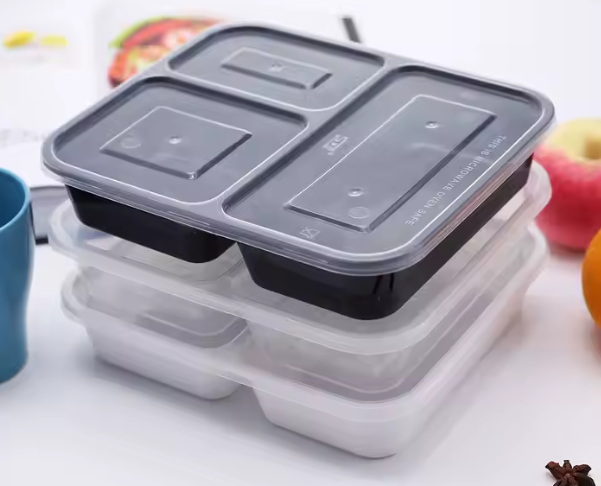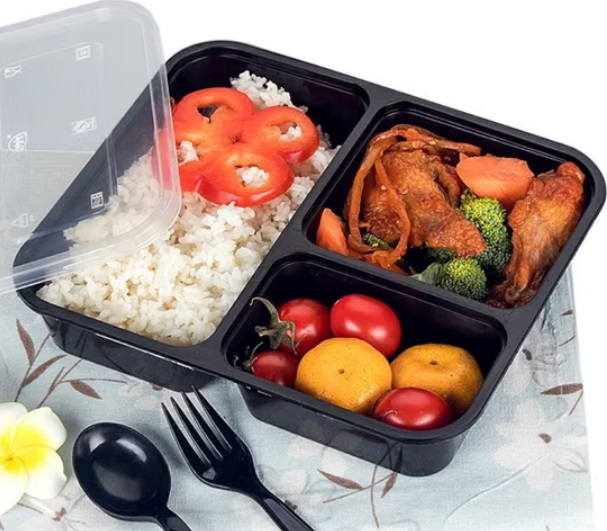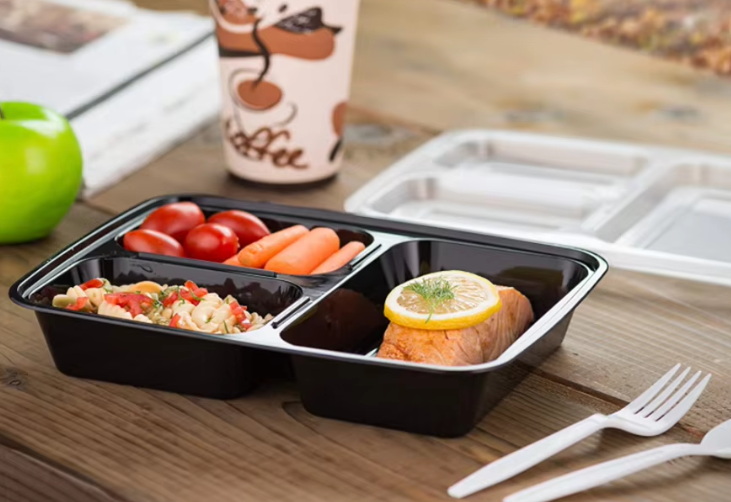
Content Menu
● What Is a 3 Compartment Disposable Lunch Box?
● Why Is Microwave Safety Important?
● Materials Used in 3 Compartment Disposable Lunch Boxes
>> 1. Polypropylene (PP)
>> 2. Polystyrene (PS)
>> 3. Plant Fiber (Bagasse)
>> 4. PET/PETE (Polyethylene Terephthalate)
>> 5. Aluminum
● How to Determine if a Lunch Box Is Microwave Safe
>> Check the Label
>> Inspect the Material Code
>> Perform a Simple Test
● Best Practices for Microwaving Disposable Lunch Boxes
>> Remove Lids Before Heating
>> Avoid Overheating
>> Stir Food Midway
>> Use Alternatives When in Doubt
● Environmental Impact of Disposable Lunch Boxes
● Benefits of Using a 3 Compartment Disposable Lunch Box
>> Portion Control
>> Convenience
>> Versatility
>> Cost-Effective
>> Leak-Proof Design
● Conclusion
● FAQ Section
>> 1. What materials make a 3 compartment disposable lunch box microwave safe?
>> 2. Can I microwave a polystyrene lunch box?
>> 3. How long can I microwave a disposable lunch box?
>> 4. Are plant fiber lunch boxes better than plastic ones?
>> 5. What should I do if my disposable lunch box gets damaged?
The modern lifestyle demands convenience, especially when it comes to food storage and preparation. For many, the 3 compartment disposable lunch box has become an essential tool. These lunch boxes are perfect for separating meals, ensuring portion control, and keeping food fresh. However, one pressing question remains: Are these lunch boxes microwave safe? With the growing reliance on microwaves for reheating food, understanding the safety of these containers is crucial.
In this article, we'll dive deep into the materials used in 3 compartment disposable lunch boxes, how to determine their microwave safety, and best practices for usage. Additionally, we'll explore their benefits, environmental impact, and practical tips for choosing the right lunch box for your needs.

What Is a 3 Compartment Disposable Lunch Box?
A 3 compartment disposable lunch box is a food container designed with three separate sections. These compartments allow users to store different types of food without mixing them. For example:
- One compartment can hold rice or pasta.
- Another can store vegetables or salad.
- The third can be reserved for proteins like chicken or fish.
This design is particularly popular among meal preppers, fitness enthusiasts, and busy professionals who need an organized way to carry their meals. Disposable lunch boxes are typically made from materials such as plastic, plant fiber, or aluminum.
Why Is Microwave Safety Important?
Microwaving food in unsafe containers can have serious health implications. Certain materials may release harmful chemicals when exposed to high temperatures. These chemicals can leach into your food and pose risks such as:
1. Hormonal disruption due to exposure to BPA (Bisphenol A).
2. Potential carcinogenic effects from certain plastics.
3. Contamination of food with microplastics.
Understanding whether your 3 compartment disposable lunch box is microwave safe ensures that you can reheat meals without compromising your health or the quality of your food.
Materials Used in 3 Compartment Disposable Lunch Boxes
To determine whether a lunch box is microwave safe, it's essential to understand the materials used in its construction. Let's examine the most common materials:
1. Polypropylene (PP)
Polypropylene is one of the safest plastics for microwaving. It is durable, heat-resistant (up to 120°C), and does not release harmful chemicals when exposed to high temperatures. PP containers are often marked with the recycling code "5" and are widely used for disposable lunch boxes.
2. Polystyrene (PS)
Polystyrene is a lightweight plastic commonly used for takeout containers. However, it has low heat resistance and can release toxic chemicals when microwaved at high temperatures (above 90°C). Polystyrene containers should be avoided for microwave use unless explicitly labeled as microwave safe.
3. Plant Fiber (Bagasse)
Plant fiber containers are made from natural materials like sugarcane pulp or wheat straw. These eco-friendly options are biodegradable and compostable. They are also highly heat-resistant, making them safe for microwaving up to 450°F.
4. PET/PETE (Polyethylene Terephthalate)
While PET containers are commonly used for cold storage, they are not always suitable for microwaving unless specifically labeled as microwave safe. Heating PET containers can cause them to warp or degrade over time.
5. Aluminum
Aluminum containers are excellent for storing food but are not suitable for microwaves due to the risk of sparking or fire hazards.

How to Determine if a Lunch Box Is Microwave Safe
Here are some practical steps you can take to assess whether your 3 compartment disposable lunch box is safe for microwave use:
Check the Label
Most manufacturers include a "microwave-safe" label on their products if they are suitable for heating in a microwave. Look for symbols such as wavy lines or explicit text indicating microwave safety.
Inspect the Material Code
Plastic containers often have recycling codes at the bottom:
- Code "5" (Polypropylene) indicates microwave safety.
- Codes "6" (Polystyrene) and "1" (PET) should generally be avoided unless labeled otherwise.
Perform a Simple Test
If you're unsure about a container's safety:
1. Fill it with water.
2. Microwave it on high for one minute.
3. If the container remains cool while the water heats up, it's likely microwave safe.
Best Practices for Microwaving Disposable Lunch Boxes
To ensure safe usage of your 3 compartment disposable lunch box, follow these guidelines:
Remove Lids Before Heating
Plastic lids may melt or deform when exposed to high temperatures in a microwave. Always remove them before reheating your food.
Avoid Overheating
Limit reheating time to no more than 5 minutes at 1000W power settings. Prolonged exposure to high heat can cause even microwave-safe plastics to degrade.
Stir Food Midway
Stirring ensures even heating and prevents hot spots that could damage the container or overheat certain areas of your meal.
Use Alternatives When in Doubt
If you're unsure about the safety of your disposable lunch box, transfer your food to a glass or ceramic container before microwaving.
Environmental Impact of Disposable Lunch Boxes
While disposable lunch boxes offer convenience, they also raise concerns about sustainability:
- Plastic Waste: Non-biodegradable plastics contribute significantly to environmental pollution.
- Eco-Friendly Options: Plant fiber alternatives like bagasse are compostable and reduce waste.
- Recycling Challenges: Many disposable containers cannot be recycled due to contamination from food residues.
To minimize environmental impact:
1. Opt for biodegradable or compostable materials.
2. Reuse plastic containers when possible.
3. Dispose of non-recyclable items responsibly.
Benefits of Using a 3 Compartment Disposable Lunch Box
The popularity of these lunch boxes stems from their numerous advantages:
Portion Control
The separate compartments help users manage portion sizes effectively, making them ideal for weight management and meal prep.
Convenience
Disposable lunch boxes save time on cleaning and storage while offering an easy way to pack meals for work, school, or travel.
Versatility
They can accommodate various types of meals—hot or cold—and are suitable for diverse cuisines.
Cost-Effective
Affordable pricing makes them accessible to individuals and businesses alike.
Leak-Proof Design
Many models feature airtight lids that prevent spills and maintain freshness during transport.
Conclusion
The question "Is a 3 compartment disposable lunch box microwave safe?" depends largely on its material composition and proper usage techniques. Polypropylene and plant fiber options provide safe solutions for reheating meals in the microwave, while polystyrene should be avoided altogether. By checking labels, following best practices, and considering eco-friendly alternatives, you can enjoy the convenience of these versatile containers without compromising safety or sustainability.
Whether you're meal prepping for a busy week or packing lunches on the go, understanding how to use these containers safely ensures that you get the most out of their functionality while protecting your health and the environment.

FAQ Section
1. What materials make a 3 compartment disposable lunch box microwave safe?
Microwave-safe materials include polypropylene (PP) and plant fiber (bagasse). Look for recycling code "5" or specific microwave-safe labels on the box.
2. Can I microwave a polystyrene lunch box?
No, polystyrene (PS) containers should not be microwaved as they can release harmful chemicals when heated above 90°C.
3. How long can I microwave a disposable lunch box?
Most microwave-safe disposable lunch boxes can be heated for up to 5 minutes at 1000W power settings. Always follow the manufacturer's instructions.
4. Are plant fiber lunch boxes better than plastic ones?
Yes, plant fiber lunch boxes are eco-friendly, compostable, and handle higher temperatures than most plastics, making them a safer choice for microwaving.
5. What should I do if my disposable lunch box gets damaged?
Do not use damaged containers in the microwave as they may release harmful chemicals into your food. Replace them with new ones or opt for reusable alternatives.

















